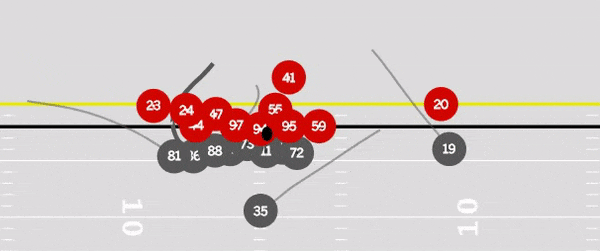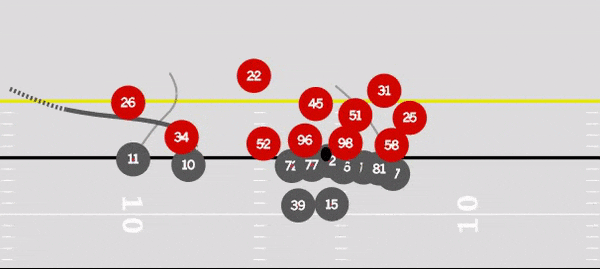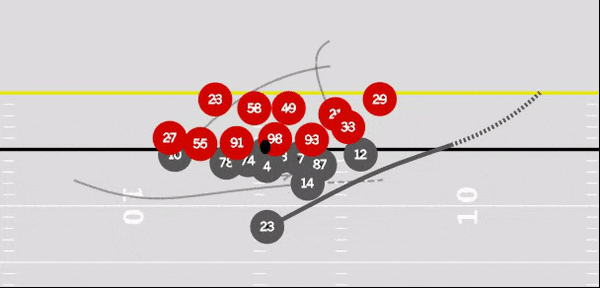If you can't convert on the goal line in the NFL you might as well pack up and go home. Punching in touchdowns from inside the 5-yard line is crucial -- you can't pass up those opportunities in today's offensive game.
So who are the best of the best at crossing the plane in the "tight red zone," and which teams are best equipped to find pay dirt from in close? And what play calls and schemes are most effective inside the 5-yard line? Forget the fade -- I want easy touchdowns.
We picked the top players, teams and schemes when it comes to converting those short, short-field downs.
Jump to top ...
Players | Schemes | Teams

BEST PLAYERS INSIDE THE 5-YARD LINE
Ezekiel Elliott, RB, Dallas Cowboys
Elliott tied for the league lead last season with 10 rushing scores inside the 5-yard line. His successful carry rate in that range (based on expected points added, or EPA) was 55.6%, good for sixth overall in the NFL (min. 15 rushes).
Zeke's leg drive jumps on film. He can push through contact to reach the end zone. Vision and quick jump-cut ability are also plus qualities, allowing Elliott to find those small slices of daylight. And Elliott is a finisher -- a downhill back who runs with power behind his pads on both zone and power schemes. Given the consistent traits that lead to scoring production here, I see Elliott as the league's top runner in the tight red-zone area of the field.
Lamar Jackson, QB, Baltimore Ravens
Jackson registered 12 total touchdowns last season in the tight red zone, throwing for nine scores and picking up three more as a runner. Given his high-end dual-threat traits, the Ravens can scheme for Jackson in the pass game on boot, play-action and man-coverage beaters out of multiple tight end sets. And with Jackson's electric ability as a ball carrier, Baltimore's designed QB run concepts can create conflict for opposing defenses, like we saw in the Ravens' win over the Patriots last season.
TOUCHDOWN RUN @LJ_ERA8 ‼️ ‼️ pic.twitter.com/iZhBjgyszZ
— Baltimore Ravens (@Ravens) November 4, 2019
Dalvin Cook, RB, Minnesota Vikings
In 2019, Cook led the NFL with 21 rushes in the tight red zone, while scoring nine touchdowns. And, really, it's the game speed with Cook. He can scoot, with an immediate burst to slice through open daylight.
The Vikings also cater to his running style with edge runs on outside zone schemes and the toss plays that allow Cook to head for the pylon or cut back inside to reach the end zone. Cook has some serious pop in his pads, which puts him in a position to drop the hammer on the goal line, too. It's the traits and scheme fit that put the Vikings' running back near the top of the list.
Zach Ertz, TE, Philadelphia Eagles
Ertz tied for the league lead with four touchdown receptions last season in the tight red zone, and since the 2017 season, his 11 touchdown receptions there are tied for most in the NFL with New Orleans Saints wide receiver Michael Thomas.
Yes, coach Doug Pederson is going to scheme for Ertz in this area of the field, but don't sleep on the matchup ability or the route-running traits of the Eagles' tight end here. Ertz is smooth through the route stem, weaving defenders in coverage and gaining separation to the ball. Plus, with his 6-foot-5 frame and catch radius, Ertz can also body up defensive backs to create leverage to the ball.
Julio Jones, WR, Atlanta Falcons
From 2016 to 2018, Jones only totaled five touchdown receptions inside the tight red zone. But with four scores last season and his rare matchup traits, the Falcons wide receiver is still one of the league's most dangerous threats with the ball near the goal line.
Yes, I would like to see the Falcons scheme more targets for Jones here on pick/rub concepts. But given Jones' elite combination of size, athleticism and route running, creating isolation matchups gives the Falcons an advantage on slants, quick outs and back-shoulder throws.
Aaron Jones, RB, Green Bay Packers
Jones tied Elliott for the NFL lead with 10 rushing scores in the tight red zone, including a successful carry rate of 63.2%, which ranked No. 2 in the NFL. The Packers running back has the wiggle to slip defenders here, and he plays with low pad level on the goal line. Plus, Jones' ability to accelerate in an instant allows him to bounce the ball outside. He is a prime fit for Matt LaFleur's run game inside the 5-yard line on both outside zone and the inside schemes that put him in a position to drive though the wash.
Aaron Jones scores his third TD of the game! @Showtyme_33@Packers lead 24-0. #GoPackGo #GBvsDAL
— NFL (@NFL) October 6, 2019
📺: FOX
📱: NFL app // Yahoo Sports app
Watch free on mobile: https://t.co/d6meepU6Nz pic.twitter.com/pHI8PNnhtD
Honorable Mention: Cam Newton, QB, New England Patriots
If healthy and playing the No. 1 role for the Patriots, Newton is one of the league's best near the goal line given his unique physical and athletic traits as a runner. From 2015 to 2018, Newton led all quarterbacks with 30 carries inside the 5-yard line, and his 19 touchdown runs ranked fifth overall during that stretch. He's a dynamic offensive weapon when the ball is on the doorstep.

BEST SCHEMES INSIDE THE 5-YARD LINE
Inside zone
Spread the defense out and attack inside. I'm a big believer in bringing 11 personnel (1 RB, 1 TE and 3 WR) onto the field with the running back in the shotgun or pistol set. This creates a lighter box up front, while putting the tailback in a position to use his eyes to find the seam and go. And if you have a quarterback with running traits, you can add another layer of stress, influencing the play speed for both perimeter and interior defenders on zone read/run-pass options off the inside zone scheme. There's a lot to work with here.
Tight end 'follow' concept
The "follow" concept (shallow crosser paired with an angle route) can be run from multiple personnel groupings and alignments to beat both zone and man coverage. You can clear or occupy the inside defender on the crosser and create a window for the angle route to break back across the face of the outside defender.
It is perhaps best on display in the Eagles' offense, with Carson Wentz -- who led the NFL with 12 tight red-zone touchdown passes -- targeting Ertz out of multiple tight end sets. The duo connected for such a score in the team's Week 14 win over the New York Giants, shown here in NFL Next Gen Stats animation.

With 13 personnel in the game (1 RB, 3 TE and 1 WR), the Eagles remove the linebacker on the shallow crosser from Dallas Goedert, which now creates the matchup Doug Pederson wants: Ertz versus a defensive back in coverage. That allows Ertz to stem outside on the release, forcing the defender to overplay the route. And that opens the door for Ertz to break back inside on the touchdown throw from Wentz. Easy money.
Zone lead (toss)
We see a lot of NFL teams run Power O on the goal line out of 23 personnel (2 RB and 3 TE), getting their bigs in the game on an inside scheme. But I would avoid pulling a guard on the goal line due to the defensive line's ability to penetrate up the field or to simply knock off the puller, creating a mess of bodies at the point of attack.
Instead, let's get the ball to the edge off a toss scheme, which can still hit downhill. Look at what the Vikings did last season with Cook against the Seattle Seahawks.
.@dalvincook gets things started for your #Vikings!!!#Skol #ProBowlVote pic.twitter.com/hLC0dB41Y8
— Minnesota Vikings (@Vikings) December 3, 2019
On a zone lead concept (with the toss action), the Vikings pull the front-side tackle to kick out the cornerback on the edge. That creates the running lane for the fullback to lead the way to the second level, with Cook picking his spot to accelerate to the end zone. Remember, this scheme hits fast, and when gaps move on the toss action, it creates conflict for the defense.
Pick/rub concept
NFL defenses played man coverage on 92% of snaps inside the 5-yard line across the league last season, so you know what you're getting here. That's why I love consistently setting up defenses in this area of the field by forcing defensive backs or linebackers to work through traffic and picks in man coverage.
On a Patrick Mahomes-Tyreek Hill hookup in Week 15 against the Denver Broncos -- in the snow -- the Kansas City Chiefs ran a staple pick/rub concept. See it in action with NFL Next Gen Stats animation.

Out of a twins formation, with the back shifting to an offset alignment, the outside wide receiver, Demarcus Robinson, releases inside to "pick" the defender in coverage versus Hill. That creates instant separation for Hill to burst to the flat on an easy toss from Mahomes to get the score.
Boot
The speed of the game jumps inside the tight red zone. That's why boot concepts off play-action or misdirection get it done. Boot concepts grab the eyes of the defenders in an area of the field where there is no time to recover from a false step or a poor read. Here's a prime example, via NFL Next Gen Stats animation, from the Houston Texans' wild-card win over the Buffalo Bills last season: a 5-yard touchdown on a boot "hot" concept.

The Texans use both misdirection (a jet sweep) and play-action to get the running back quickly to the flat. With the backside crosser, quarterback Deshaun Watson now has layered reads off boot action. With his dual-threat ability, Watson can run this play like a point guard, distributing the ball to an open receiver or pulling it down as a runner. In this case, he drops it off to Carlos Hyde. When you have a quarterback with the athletic traits to move outside of the pocket, the boot concepts should be at the top of the game plan.

BEST TEAMS INSIDE THE 5-YARD LINE
Tennessee Titans
The Titans have all the key elements to produce in the tight red-zone area of the field, which is why Tennessee posted a 72.7% successful play rate inside the 5-yard line last season. It's a physical group with versatility in the call sheet.
It starts up front with an offensive line that comes off the ball. They can move people in the run game with inside and outside zone, power and more. That opens the door for 6-foot-3, 247-pound running back Derrick Henry, who scored seven touchdowns on 11 carries inside the 5-yard line last season.
At quarterback, Ryan Tannehill posted seven total touchdowns in the tight red zone. With the play-action and boot concepts here, along with his second-reaction ability and movement traits, Tannehill can threaten defenses as a dual-threat option. And with two matchup targets in the pass game -- wide receiver A.J. Brown and tight end Jonnu Smith -- Tennessee can scheme throws into the end zone.
Philadelphia Eagles
The Eagles posted a successful play rate of 64.0% inside the 5-yard line in 2019. With Wentz's ability to make tight-window throws and play off-schedule, the Eagles can scheme up tight ends in the pass game. And given the athletic upside of rookie wide receiver Jalen Reagor, I expect Pederson to use his traits this season on fly sweeps and screens in the tight red zone. Then there is the ability of running back Miles Sanders, who allows the Eagles to run inside zone schemes with the ball close to the end zone.
